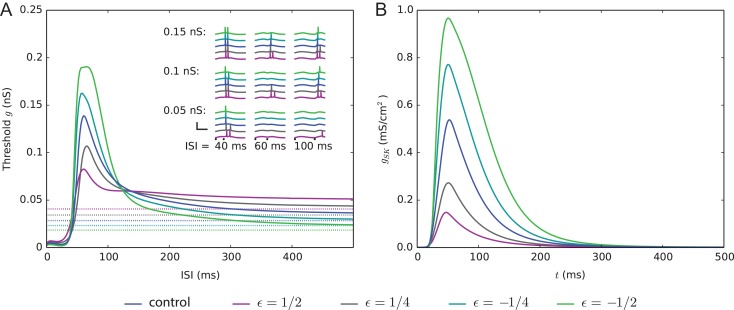Figure 5.
The single-L5PC model predicts that the combination of variants increasing the network firing causes deficits in prepulse inhibition. (A) The solid curves show the threshold conductance for the second input arriving simultaneously to the 3000 synapses located at the apical dendrite. The dashed lines show the threshold conductance for the same input at rest; thus, the solid curves converge toward the dashed lines. For the positively scaled model variants (ε = 1/2 and 1/4), a deficit in prepulse inhibition, that is, lowered threshold conductance for the second input, was observed when the interval between the first and the second inputs is approximately 40–120 ms. The insets show the somatic membrane potential traces following the two stimuli, given different intervals and synaptic conductances of the second stimulus. If the two inputs were close in time (ISI = 40 ms), the neuron always fired at least one action potential shortly after the second stimulus. Likewise, if the interval between the two inputs was long (ISI = 100 ms), the neuron fired when the conductance of the second input was either g = 0.1 or 0.15 nS (ε = 1/2 variant fired also for g = 0.05 nS). By contrast, there was a lot of variation between the model variants in what happens for intermediate interval (ISI = 60 ms): ε = -1/2 variant did not fire for any of the three amplitudes of the second stimulus, ε = 1/2 fired for both g = 0.1 and 0.15 nS, and the behaviors of the other variants fell between these two extremes. (B) The SK current, recorded at the “hot zone” of Ca2+ channels (720 μm from the soma at the apical dendrite) in the single-L5PC model of Hay et al. (2011), both in the control case and when the combinations of model variants were used. Only the prestimulus (90% of the threshold conductance) was applied here.

